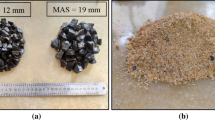Abstract
This paper presents an experimental study on the properties and on the durability of concrete containing ceramic wastes. Several concrete mixes possessing a target mean compressive strength of 30 MPa were prepared with 20% cement replacement by ceramic powder (W/B = 0.6). A concrete mix with ceramic sand and granite aggregates were also prepared as well as a concrete mix with natural sand and coarse ceramic aggregates (W/B = 0.5). The mechanical and durability performance of ceramic waste based concrete are assessed by means of mechanical tests, water performance, permeability, chloride diffusion and also accelerated aging tests. Results show that concrete with partial cement replacement by ceramic powder although it has minor strength loss possess increase durability performance. Results also shows that concrete mixtures with ceramic aggregates perform better than the control concrete mixtures concerning compressive strength, capillarity water absorption, oxygen permeability and chloride diffusion. The replacement of cement and aggregates in concrete by ceramic wastes will have major environmental benefits.
















Similar content being viewed by others
Change history
09 July 2021
A Correction to this paper has been published: https://doi.org/10.1617/s11527-021-01737-3
References
Fernandes M, Sousa A, Dias A (2004) Environmental impact and emissions trade. Ceramic industry. A case study. Portuguese Association of Ceramic Industry APICER
Mehta PK (2001) Reducing the environment impact of concrete. Concrete can be durable and environmentally friendly. Concr Int 10:61–66. http://www.ce.berkeley.edu/~paulmont/CE60New/Concrete%20and%20the%20Environment.pdf
Meyer C (2009) The greening of the concrete industry. Cem Concr Compos 31:601–605. doi:10.1016/j.cemconcomp.2008.12.010
Gartner E (2004) Industrially interesting approaches to low-CO2 cements. Cem Concr Res 34:1489–1498. doi:10.1016/j.cemconres.2004.01.021
Lavat A, Trezza M, Poggi M (2009) Characterization of ceramic roof tile wastes as pozzolanic admixture. Waste Manage 29:1666–1674. doi:10.1016/j.wasman.2008.10.019
Naceri A, Hamina M (2009) Use of waste brick as a partial replacement of cement in mortar. Waste Manage 29:2378–2384. doi:10.1016/j.wasman.2009.03.026
Puertas F, Garcia-Diaz I, Barba A, Gazulla M, Palacios M, Gomez M, Martinez-Ramirez S (2008) Ceramic wastes as alternative raw materials for Portland cement clinker production. Cem Concr Compos 30:798–805. doi:10.1016/j.cemconcomp.2008.06.003
Binici H (2007) Effect of crushed ceramic and basaltic pumice as fine aggregates on concrete mortar properties. Constr Build Mater 21:1191–1197. doi:10.1016/j.conbuildmat.2006.06.002
Cachim P (2009) Mechanical properties of brick aggregate concrete. Constr Build Mater 23:1292–1297. doi:10.1016/j.conbuildmat.2008.07.023
NP EN 12620 (2004) Aggregates for concrete. Portuguese Laboratory of Civil Engineering—LNEC
NP EN 197-1 (2001) Cement—Part 1: Composition, specifications and conformity criteria for common cements. Portuguese Laboratory of Civil Engineering—LNEC
NP EN 12350-2 (2002) Testing fresh concrete. Part 1: Slump test. Portuguese Laboratory of Civil Engineering—LNEC
NP EN 12390-3 (2003) Testing hardened concrete. Part 3: Compressive strength. Portuguese Laboratory of Civil Engineering—LNEC
LNEC E393 (1970) Concrete: determination of capillarity water absorption
Guerra I, Vivar I, Llamas B, Juan A, Moran J (2009) Eco-efficient concretes: the effects of using recycled ceramic material from sanitary installations on the mechanical properties of concrete. Waste Manage 29:643–646. doi:10.1016/j.wasman.2008.06.018
Lopez V, Llamas B, Juan A, Moran J, Guerra I (2007) Eco-efficient concretes: impact of the use of white ceramic powder on the mechanical properties of concrete. Biosyst Eng 96:559–564. doi:10.1016/j.biosystemseng.2007.01.004
Brito J, Pereira A, Correia J (2005) Mechanical behaviour of non-structural concrete made with recycled ceramic aggregates. Cem Concr Compos 27:429–433. doi:10.1016/j.cemconcomp.2004.07.005
Khatib J (2005) Properties of concrete incorporating fine recycled aggregate. Cem Concr Res 35:763–769. doi:10.1016/j.cemconres.2004.06.017
Oh B, Cha S, Jang B, Jang S (2002) Development of high-performance concrete having high resistance to chloride penetration. Nucl Eng Des 212:221–231. doi:10.1016/S0029-5493(01)00484-8
Mora E (2007) Life cycle, sustainability and the transcendent quality of building materials. Build Environ 42:1329–1334. doi:10.1016/j.buildenv.2005.11.004
Directive 203/87/Ec (October 2003) European Union CO2 emissions trading scheme
European Environmental Agency (2008) Greenhouse gas emission trends and projections in Europe. EEA technical report no. 5/2008
Soulé M, Sanjayan M (1998) Conservation targets: do they help? Science 279:2060–2061. doi:10.1126/science.279.5359.2060
Myers N, Mittermeier R, Mittermeier C, Fonseca G, Kent J (2000) Biodiversity hotspots for conservation priorities. Nature 403:853–858. http://www.ithaca.edu/faculty/rborgella/environment/biodiversity_hotspot.pdf
Author information
Authors and Affiliations
Corresponding author
About this article
Cite this article
Pacheco-Torgal, F., Jalali, S. RETRACTED ARTICLE: Compressive strength and durability properties of ceramic wastes based concrete. Mater Struct 44, 155–167 (2011). https://doi.org/10.1617/s11527-010-9616-6
Received:
Accepted:
Published:
Issue Date:
DOI: https://doi.org/10.1617/s11527-010-9616-6




